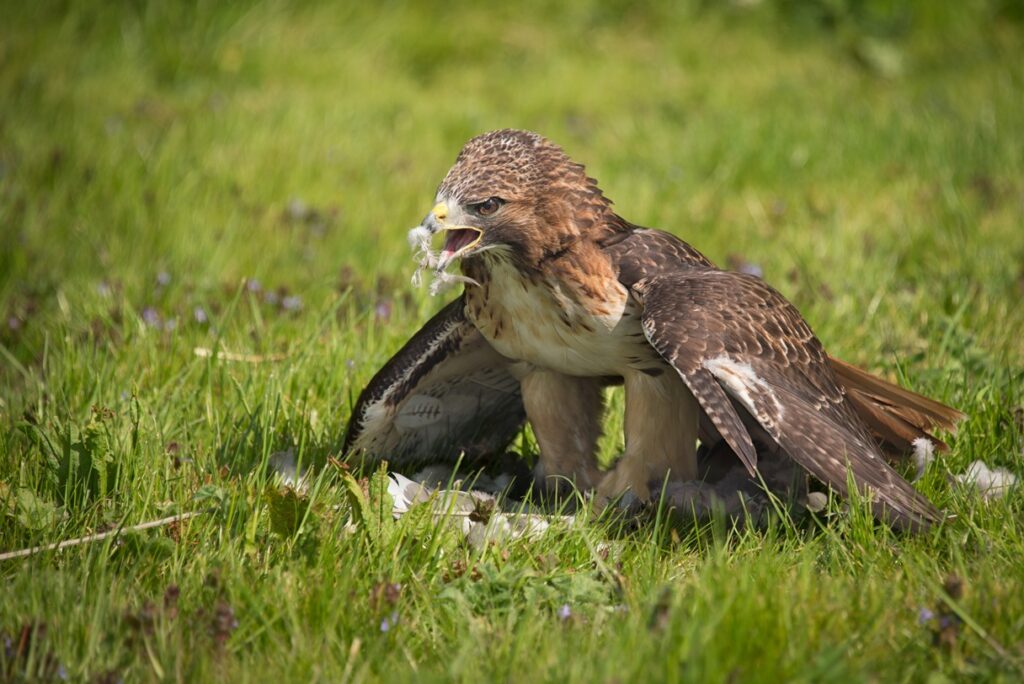Hawks are a bird of prey known for their sharp talons and hooked beaks, found in habitats worldwide, including forests, grasslands, and deserts. These birds are apex predators that play a vital role in the ecosystems where they live.
All hawks, including Red-tailed Hawks, Cooper’s Hawks, and Sharp-shinned Hawks, are carnivorous and eat small mammals, fish, birds, reptiles, and amphibians. They are skilled hunters and can spot their prey while high in the air.
Small hawk species, like Cooper’s Hawks, typically eat smaller prey items, such as mice, voles, small birds, frogs, toads, and lizards. Large hawk species, like Red-tailed Hawks, typically eat larger prey such as rabbits, groundhogs, fish, snakes, and large birds.
Falconers practice falconry and use hawks to capture desirable game species. These preferred species include rabbits, squirrels, ducks, grouse, pheasant, doves, quail, and partridges. Falconers feed their hawks live animals or fresh meat to keep the birds healthy.
What Do Hawks Eat in the Winter?
Hawks that live in northern parts of the world where winter temperatures get very cold migrate south for the winter. Some species migrate long distances while others only need to travel a short distance to where winter habitats have plenty of food.
In the winter, hawks eat many of the same animals they eat in the summer, with a few exceptions. Hawks eat mice, voles, rabbits, birds, and insects during the winter, but amphibians and reptiles hibernate during the winter months and are not part of their diet.
Hawks are opportunistic predators, so they eat whatever is available and abundant. In the winter, when food is scarce, they may travel long distances to find prey. They may also scavenge for food by eating carrion.
What Do Hawks Eat in the City?
Hawks are carnivorous and eat many small animals, including rodents, rabbits, birds, reptiles, and amphibians. In the city, hawks usually eat pigeons, rats, and small birds because they are abundant, while in rural areas, hawks can find a wider variety of small animals.
In addition, some city-dwelling hawks may also eat insects, such as grasshoppers, moths, beetles, and crickets. Hawks are apex predators in cities, helping to control the populations of several pest species, especially those that may carry diseases.

What Is a Hawk’s Favorite Food?
Because of their excellent eyesight, hawks can see prey from long distances above the ground. The distance hawks can see is dependent on the species. Red-tailed Hawks have the best visual acuity and can see the furthest of the hawk species.
Large hawks, like Red-tailed Hawks, prefer eating small rodents, such as mice, voles, rats, rabbits, and squirrels. These small mammals are plentiful worldwide, and hawks can always find these animals scurrying around no matter where they hunt for food.
Small hawks, like American Kestrels, prefer eating invertebrates, especially beetles and crickets. The preferred prey that hawks eat depends on their habitat and the local species’ assemblage where they live.
What Do Baby Hawks Eat?
Adult hawks feed their nestlings, also called eyases, until they fledge and begin hunting for themselves. Baby hawks are carnivorous, eating a diet of small mammals, such as mice, rats, rabbits, birds, reptiles, amphibians, and insects, depending on the hawk species.
During the first 4 to 5 weeks, the father typically hunts while the mother stays with the nestlings and rips the prey gathered by the father into small pieces for her babies. Once they are old enough, both parents hunt for food and drop it into the nest, where the babies rip it themselves.
Baby hawks fledge after about 6 to 7 weeks but stay with their parents for several weeks more. As fledglings, hawks eat small prey items until they improve their hunting skills. As they mature, they start eating larger prey such as rodents, rabbits, squirrels, and other birds.
How Often Do Hawks Eat?
At certain times of the year, prey availability is scarce in some places. Hawks typically migrate to areas with a greater abundance of prey during these times, but sometimes they choose to be year-round residents.
Hawks typically eat every one to three days, depending on the hawk’s size and the size of their prey. Large hawks that capture large prey survive longer between meals than small hawks that subsist on smaller prey items. The smaller the prey item, the more frequently hawks eat.
